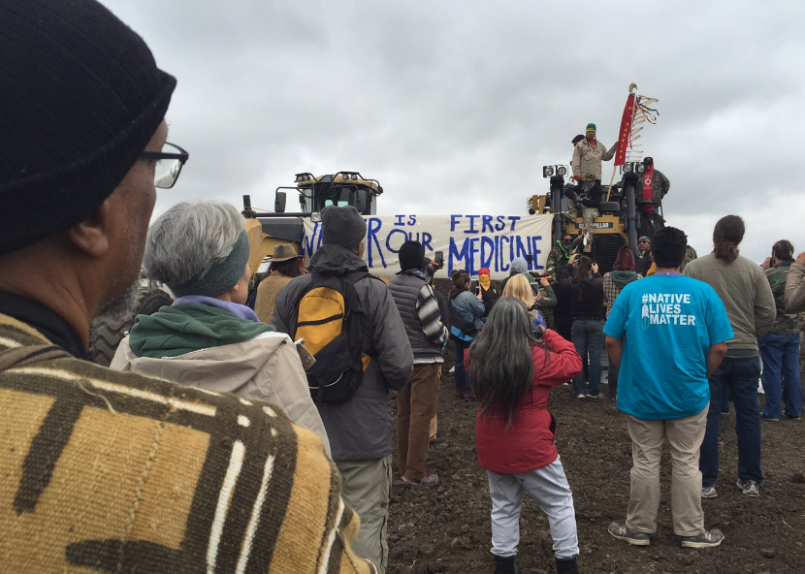Favorites
Standing Rock is part of a long tradition of Native resistance

Image: Twitter
The United States has a long history of fucking with American Indians just because it can. From using Native people as guinea pigs in social policy experiments (boarding schools, anyone? Termination policy?) to simply violating treaties whenever it suited the interests of white settlers. The law protects your right to your land? Not if white farmers and ranchers want it, as happened in the Dakota Territory in the late nineteenth century. The Sioux, among other Indian nations, were promised by the 1868 Treaty of Fort Laramie possession of millions of acres of land that the United States government simply stripped away to make room for white settlement in the Dakotas. The federally-recognized Standing Rock Sioux, along with several other Indian nations, organizations, and allies are now challenging corporate plans to construct an oil pipeline across historic Sioux lands, arguing the pipeline’s projected path under the Missouri River threatens the tribe’s water supply and construction in the area has already destroyed priceless historic and sacred sites on lands they have been legally guaranteed by treaty for almost a hundred and fifty years. The protests against the Dakota Access Pipeline, now going into their fifth month, are also part of a long tradition of Indigenous resistance. In court and on the ground at the proposed construction site, the Standing Rock Sioux are fighting back against degradation of their land and culture.
The corporation behind the Dakota Access Pipeline, Texas-based Energy Transfer Partners, and the American public might be surprised at Standing Rock’s pushback against the pipeline, considering the United States government, white settlers, and private corporations have literally been getting away with these kinds of actions for centuries. This isn’t even Standing Rock’s first brush with land theft and environmental destruction in living memory: in 1958, the Army Corps of Engineers and Bureau of Reclamation seized 56,000 acres of reservation land to build the Oahe Dam and Reservoir on the Missouri River, destroying Indian towns and homes in the process. The displaced and their descendants still haven’t been compensated for their losses. So why not build an oil pipeline under their drinking water supply? Why not destroy their sacred sites? Land theft and environmental destruction in Indian country has long been good business for Americans and American corporations.
While the #NoDAPL movement is being touted in the international media as “the largest gathering of Native Americans in more than 100 years,” it certainly is not unprecedented. From the 1850s to the 1870s, the Sioux militarily resisted confinement on reservations and the United States’ attempts to destroy their economy and culture and take away reservation land without Sioux consent. The most famous episode in these so-called “Indian Wars” was the 1876 Battle of the Greasy Grass (known to Americans as the Battle of the Little Bighorn), in which Sioux, Arapaho, and Cheyenne warriors destroyed Lieutenant Colonel George Armstrong Custer’s Seventh Cavalry. In the twentieth century, the Sioux worked with the American Indian Movement in the 1970s on a range of issues, including the failure of law enforcement to prosecute whites for crimes against Indians, Bureau of Indian Affairs complicity in corruption and violence on the Pine Ridge reservation in South Dakota, and demands for the United States to respect treaty rights.
Much like the #NoDAPL protesters in North Dakota today, the American Indian Movement activists of the 1970s occupied and disrupted businesses and federal government offices to draw attention to their cause. Like today’s protesters, who have been met with attacks by private security guards, the protests of the 1970s drew fierce reprisals from the FBI and US military. And like the Standing Rock Sioux nation’s efforts to block construction of the pipeline through the federal court system, so too have Sioux activists of the past 100 years used the United States courts to enforce treaty rights and attempt to regain land, most famously to regain the Black Hills, a sacred region Congress illegally seized from the Sioux in 1876.
This past weekend, when protesters clashed with private security guards and their attack dogs, getting bitten and pepper sprayed in the process, Dakota Access, the subsidiary of Energy Transfer Partners in charge of the pipeline project, in a court filing on Tuesday accused the protesters of harassing company employees, vandalizing company property, and, most ironically, illegal trespass. Yep, that’s right: the people that will destroy sacred sites and jeopardize Standing Rock’s drinking water are complaining about vandalism and trespass. Maybe the folks at Dakota Access can cry me a river, then build their pipeline under it instead.
This article originally appeared on MensTrait.com as Standing Rock is part of a long tradition of Native resistance.





0 comments